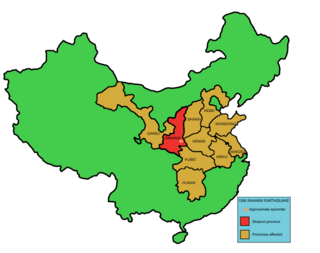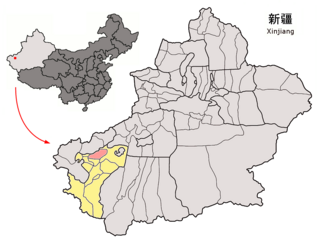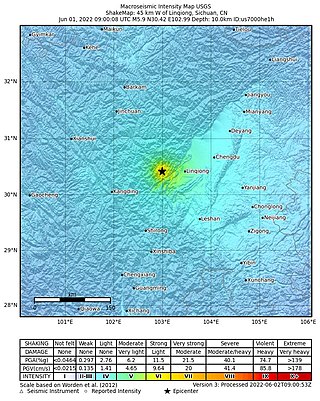Related Research Articles
The Great Chinese Famine was a famine that occurred between 1959 and 1961 in the People's Republic of China (PRC). Some scholars have also included the years 1958 or 1962. It is widely regarded as the deadliest famine and one of the greatest man-made disasters in human history, with an estimated death toll due to starvation that ranges in the tens of millions. The most stricken provinces were Anhui, Chongqing (15%), Sichuan (13%), Guizhou (11%) and Hunan (8%).

The 1556 Shaanxi earthquake, known in Chinese colloquially by its regnal year as the Jiajing Great Earthquake "嘉靖大地震" or officially by its epicenter as the Hua County Earthquake "华县地震", occurred in the early morning of 23 January 1556 in Huaxian, Shaanxi during the Ming dynasty.

Payzawat County, also via SASM/GNC romanization as Payziwat County, and via Mandarin Chinese as Jiashi County is a county in Kashgar Prefecture, Xinjiang Uyghur Autonomous Region, China, on the western rim of the Taklamakan Desert. To the east, the county borders Maralbexi County, to the south Yopurga County.

Yutian County, also transliterated from Uyghur as Keriya County, is a county in Hotan Prefecture, Xinjiang Uyghur Autonomous Region, China. It is based at the Keriya Town, and is separate from Hotan County, which is another county in the same prefecture. The Yutian County has an area of 39,023 km2 (15,067 sq mi). According to the 2002 census, it has a population of 220,000. The county is bounded on the north by Aksu Prefecture, on the east by Minfeng/Niya County, on the west by Qira County and on the south by the Rutog and Gertse counties of the Tibet Autonomous Region.
Ling Zhang is a former senior audiologist and fiction writer in Toronto, Canada. She was born in Wenzhou, China and came to Canada in 1986 to pursue her MA in English at University of Calgary. She obtained her second MA degree in Communication disorders at the University of Cincinnati. She has published nine novels and several collections of novellas and short stories in Chinese. One of her novels,《金山》, has been translated into English, French, and German. She has won numerous important literary prizes in China.

Wenchuan County is a county in Ngawa Tibetan and Qiang Autonomous Prefecture, Sichuan, China.

The 1920 Haiyuan earthquake occurred on December 16 in Haiyuan County, Ningxia Province, Republic of China at 19:05:53. It was also called the 1920 Gansu earthquake because Ningxia was a part of Gansu Province when the earthquake occurred. It caused destruction in the Lijunbu-Haiyuan-Ganyanchi area and was assigned the maximum intensity on the Mercalli intensity scale. About 258,707~273,407 died, making it one of the most fatal earthquakes in China, in turn making it one of the worst disasters in China by death toll.

The China Earthquake Administration is a public institution managed by the State Council at the deputy ministerial level in charge of national earthquake disaster reduction work. It is currently managed by the Ministry of Emergency Management.
Qian Gang is a Chinese non-fiction writer and journalist from Hangzhou in Zhejiang Province, China who over four decades has written hundreds of articles and dozens of books.
The Nasu people, are an ethnic group in the People's Republic of China. They are a subgroup of the Yi people and are mainly distinguished by their use of the Nasu language, one of five main branches of the Yi languages.
The 1994 Taiwan Strait earthquake occurred on 16 September 1994, at 14:20 local time in the southern Taiwan Strait. The magnitude of this earthquake was given as Mw 6.8 by the USGS and Ms 7.3 by Fujian Seismological Bureau. The epicenter was located about 150 to 180 km from the coast of the border of Guangdong and Fujian, and about 150 km southwest of Taiwan.

Cao Shui born June 5, 1982, also known as Shawn Cao, courtesy name Yaou (Eurasian), pseudonym or haoLord of Tower of Babel, is a Chinese poet, novelist, screenwriter and translator. He is one of the representative figures of Chinese Contemporary Literature. He leads the great poemism movement. In his Declaration of Great Poem, he aims to integrate sacred and secular cultures, oriental and occidental cultures, ancient and modern cultures in Chinese literature. His most notable works include the Epic of Eurasia, Secret of Heaven (trilogy), and King Peacock. His works are dedicated to rebuilding a republic in which the whole humanity can live in freedom, which he always described as Eurasia, the Top of the Tower of Babel or Kunlun Mountains. So far twenty books of Cao Shui have been published, including five poem collections, three essay collections, ten novels and one hundred episodes TV series and films. He is a member of China Writers' Association, China Film Association, and China Poetry Society. He is also the editor-in-chief of Great Poem and deputy editor-in-chief of Poetry Weekly. Currently he lives in Beijing as a professional writer and screenwriter.

Lǐ is a Chinese surname. In Mandarin it is pronounced with the dipped third tone of the four tones.

The 2014 Ludian earthquake struck Ludian County, Yunnan, China, with a moment magnitude of 6.1 on 3 August. The earthquake killed at least 617 people, injuring at least 2,400 others. As of 5 August 2014, 112 people remain missing. Over 12,000 houses collapsed and 30,000 were damaged. According to the United States Geological Survey, the earthquake occurred 29 km (18 mi) WSW of Zhaotong city at 16:30 local time (08:30 UTC).

The Chinese famine of 1906–1907 struck the middle and lower course of Huai River in Qing Dynasty from Autumn 1906 to Spring 1907, administratively in northern Anhui and northern Jiangsu provinces. This Chinese famine was directly caused by the 1906 China floods, which hit the Huai River particularly hard and destroyed both the summer and autumn harvest.

On June 1, 2022, a moment magnitude (Mw ) 5.8 or surface-wave magnitude (Ms ) 6.1 earthquake struck Lushan County in Ya'an, Sichuan Province, China. At least four people were killed and 42 were injured. The earthquake had a maximum intensity of VIII on the China seismic intensity scale, causing damage to many homes and triggering rockslides.
References
- ↑ 徐岳仁; 何宏林; 李文巧; 张伟恒; 田勤俭 (2018). "1303 年洪洞地震宏观震中修订的新证据" [New evidences for amendment of macro-epicenter location of 1303AD Hongtong earthquake]. 地震地质. 40 (5): 948.
- ↑ China Earthquake Administration, ed. (2008). 地震知识百问百答 [100 Q&As on Earthquakes]. 地震出版社. Archived from the original on 2009-05-09.
实则直接死于地震的只有十数万人,其余70余万人均死于瘟疫和饥荒 [Actually, direct deaths from earthquake amount to 100,000-odd, the remaining 700,000-odd died from plagues and famine]
- ↑ 张思源 (2013). "1920年海原大地震死亡人数考析". 西夏研究 (1): 119.
- ↑ 王瓒玮 (2016-07-28). "唐山大地震四十年:反思与"记忆"". 东方历史评论. Reprinted as: 王瓒玮 (2016-07-28). "唐山大地震40年:从死亡人数到天灾还是人祸仍是一地鸡毛". Jiemian. Archived from the original on 2021-01-15. Retrieved 2019-02-06.
- ↑ 夏明方 (2020). "家庭的解体与重生:历史视野下的唐山大地震". 文明的"双相"——灾害与历史的缠绕. 广西师范大学出版社. p. 79.
- ↑ 曹树基 (2005). 大饥荒:1959-1961年的中国人口. Hong Kong: 時代國際出版. pp. 46, 67, 117, 150. ISBN 9789889828233. Archived from the original on 2016-02-11. An excerpt is published as: 曹树基 (2005). "1959-1961年中国的人口死亡及其成因". 中国人口科学 (1).
- ↑ 文贯中; 刘愿 (2010). "从退堂权的失而复得看"大跃进"饥荒的成因和教训" (PDF). 经济学(季刊). 9 (3): 1102.
- ↑ 刘仁团 (2001). "光绪大灾对北方人口的影响". In 曹树基 (ed.). 中国人口史 第5卷: 清时期. 复旦大学出版社. pp. 601, 677, 687–689.
- ↑ Li, Lillian M. (2007). Fighting Famine in North China: State, Market, and Environmental Decline, 1690s–1990s (PDF). Stanford: Stanford University Press. p. 304. Archived from the original (PDF) on 2021-12-27.
In Gansu the estimated mortality was 2.5 to 3 million in an already sparsely populated province of only 6 million people. In Shaanxi, out of a population of 13 million, an estimated 3 million died of hunger or disease
- ↑ 李文海. "光绪3年天津粥厂大火事件:保生粥厂不"保生"". 中国文化报. Archived from the original on 2021-12-16.
- ↑ "一九七七年 六十一团那场大火" [The great fire to the 61st Regiment in 1977]. Yili Evening News. 2007-02-26. p. B06. Archived from the original on 2022-01-09.
- ↑ 汤其成; 李秀云 (1995). "水圈中的自然灾害" [Natural disaster in the Hydrosphere]. In 王劲峰 (ed.). 中国自然灾害区划——灾害区划、影响评价、减灾对策. Beijing: 中国科学技术出版社. p. 41.
- ↑ "75·8板桥水库溃坝 20世纪最大人类技术灾难". Phoenix Television. 2012-09-03. Archived from the original on 2020-03-23.
- ↑ Courtney, Chris (2018). The Nature of Disaster in China The 1931 Yangzi River Flood. Cambridge University Press. pp. 249–250.